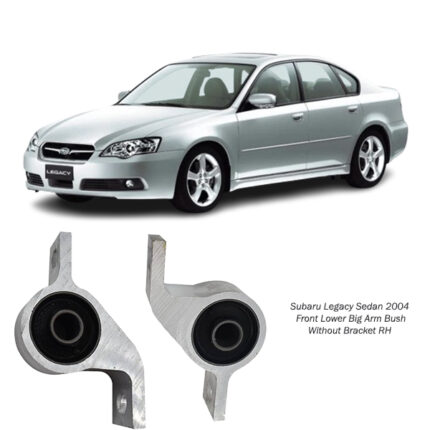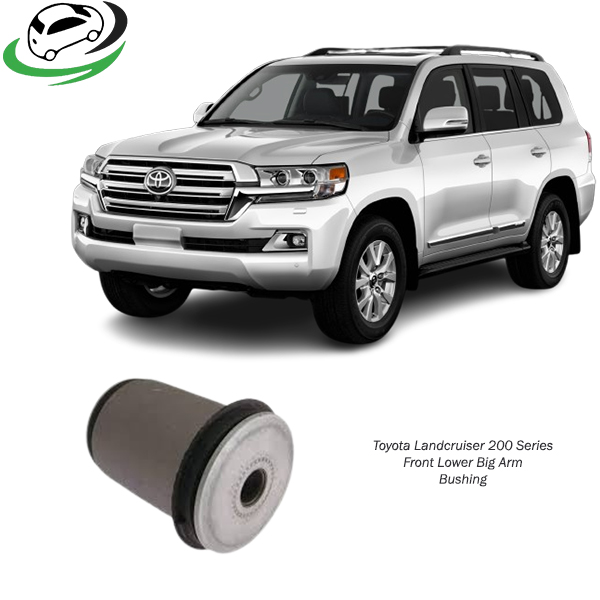-9%
Get Toyota Landcruiser 200 Series Front Lower Big Arm Bushing 48655-60040
Arm bushings, also known simply as bushings, are crucial components in a vehicle’s suspension system. They serve as the interface between various suspension parts, absorbing shocks and vibrations while providing flexibility and maintaining proper alignment. In this detailed exploration, we will delve into the components, functions, materials, types, design considerations, and maintenance of arm bushings, as well as their impact on vehicle performance and common issues.
Components and Function of Arm Bushings
- Components:
- Inner Sleeve: This metal sleeve fits tightly around the suspension arm or bolt.
- Outer Sleeve: The outer sleeve, also metal, fits into the suspension housing.
- Rubber or Polyurethane Material: Between the inner and outer sleeves, there is a rubber or polyurethane material that absorbs shocks and vibrations.
- Function:
- Vibration Dampening: Arm bushings absorb road shocks and vibrations, providing a smoother ride.
- Noise Reduction: They help in reducing noise generated by the contact between metal parts.
- Maintaining Alignment: Bushings maintain the proper alignment of suspension components, ensuring stable handling.
- Flexibility: They allow a certain amount of movement between the suspension components, which is crucial for effective suspension operation.
Materials Used in Arm Bushings
- Rubber:
- Advantages: Excellent at absorbing vibrations and providing a smooth ride.
- Disadvantages: Prone to wear and degradation over time, especially under harsh conditions.
- Polyurethane:
- Advantages: More durable than rubber, resistant to oil, chemicals, and environmental conditions. They offer better performance for high-stress applications.
- Disadvantages: Can be stiffer than rubber, potentially leading to a harsher ride.
Types of Arm Bushings
- Control Arm Bushings:
- Found in the control arms, these bushings allow the arms to pivot, helping to maintain the proper alignment of the wheels.
- Trailing Arm Bushings:
- These are located in the trailing arms, which connect the axle to the frame, allowing for controlled movement of the axle during suspension travel.
- Radius Arm Bushings:
- Radius arms connect the axle to the chassis and control the forward and backward movement of the axle. The bushings in these arms help to absorb shocks and vibrations.
- Stabilizer Bar Bushings:
- Also known as sway bar bushings, these are used in the stabilizer bars that reduce body roll during cornering.
Design Considerations
- Material Selection:
- The choice between rubber and polyurethane depends on the desired balance between comfort and performance. Rubber is preferred for comfort, while polyurethane is chosen for performance and durability.
- Size and Shape:
- The size and shape of bushings are tailored to fit specific suspension components and to provide the required level of flexibility and damping.
- Hardness:
- The hardness of the bushing material, measured on the Shore durometer scale, affects its performance. Softer bushings provide better comfort, while harder bushings offer better handling and durability.
Benefits of Arm Bushings:
1. Vibration Dampening
- Function: Arm bushings absorb and dampen vibrations generated from the road surface.
- Benefit: This results in a smoother and more comfortable ride for the passengers by isolating the vehicle’s chassis and body from road irregularities.
2. Noise Reduction
- Function: The rubber or polyurethane material of the bushings reduces noise transmission from the suspension to the vehicle’s cabin.
- Benefit: Reduced noise levels inside the vehicle lead to a quieter and more pleasant driving experience.
3. Improved Handling and Stability
- Function: Bushings maintain the proper alignment and positioning of suspension components.
- Benefit: This ensures better handling, stability, and control, especially during cornering, accelerating, and braking, enhancing the overall driving dynamics of the vehicle.
4. Increased Suspension Flexibility
- Function: Bushings allow a certain degree of movement and flexibility in the suspension arms.
- Benefit: This flexibility helps the suspension system to absorb impacts from potholes, bumps, and other road irregularities, protecting other suspension components from excessive stress and potential damage.
5. Enhanced Safety
- Function: Properly functioning bushings maintain suspension alignment and geometry.
- Benefit: This contributes to the vehicle’s stability and predictable handling, which are critical for safe driving, particularly in emergency maneuvers or adverse driving conditions.
6. Protection of Suspension Components
- Function: Bushings act as cushions between metal components in the suspension system.
- Benefit: They prevent metal-to-metal contact, reducing wear and tear on other suspension parts such as control arms, trailing arms, and the chassis itself, thereby extending their lifespan and reducing maintenance costs.
7. Cost-Effective Maintenance
- Function: Bushings are relatively inexpensive components that are easier to replace compared to other suspension parts.
- Benefit: Regular replacement of worn bushings can prevent more significant and costly damage to the suspension system, making maintenance more affordable and manageable.
8. Improved Ride Quality
- Function: By absorbing shocks and vibrations, bushings contribute significantly to the overall ride quality.
- Benefit: Passengers experience a more comfortable and less jarring ride, even on rough or uneven road surfaces.
9. Durability and Longevity
- Function: High-quality bushings, especially those made from polyurethane, offer enhanced durability and resistance to harsh environmental conditions.
- Benefit: This leads to longer service intervals and reduces the frequency of replacements, contributing to the overall reliability of the vehicle.
10. Better Tire Wear
- Function: By maintaining proper alignment and reducing unwanted movements in the suspension, bushings help distribute tire load evenly.
- Benefit: This results in more uniform tire wear, extending tire life and improving fuel efficiency due to better rolling resistance.
11. Versatility and Customization
- Function: Bushings come in various types, materials, and hardness levels, allowing customization based on specific vehicle needs and driving conditions.
- Benefit: This versatility enables vehicle owners to choose bushings that best suit their performance requirements, whether for everyday driving, off-road use, or high-performance applications.
12. Reduced Stress on Other Components
- Function: By cushioning and absorbing shocks, bushings reduce the stress transmitted to other components in the suspension and chassis.
- Benefit: This not only protects these components but also improves the overall structural integrity of the vehicle, ensuring a longer operational life and reducing the likelihood of structural damage.
Signs of worn out Arm Bushings:
1. Unusual Noises
- Clunking or Knocking: If you hear clunking or knocking sounds when driving over bumps or during sudden braking or acceleration, it could indicate that the arm bushings are worn out.
- Squeaking or Creaking: Squeaking noises, especially during turns or over uneven surfaces, can also signal deteriorated bushings.
2. Vibrations
- Steering Wheel Vibrations: Excessive vibrations in the steering wheel, particularly at higher speeds or when braking, can be a sign of worn bushings. This occurs because the bushings can no longer effectively absorb road vibrations.
- Cabin Vibrations: Increased vibrations felt throughout the vehicle cabin can also indicate bushing wear.
3. Poor Handling and Stability
- Wandering or Pulling: If the vehicle starts to wander on the road or pulls to one side, especially during braking, it could be due to worn arm bushings that are not maintaining proper alignment.
- Loose Steering: A feeling of looseness or play in the steering wheel, where the vehicle does not respond promptly to steering inputs, can be a sign of deteriorated bushings.
4. Uneven Tire Wear
- Scalloping or Cupping: Uneven tire wear patterns, such as scalloping or cupping, can indicate that the bushings are not holding the suspension components in proper alignment.
- Accelerated Wear: Rapid or uneven tire wear suggests that the suspension system is not functioning correctly, which could be due to worn bushings.
5. Increased Body Roll and Sway
- Excessive Swaying: If the vehicle exhibits excessive body roll or sway during cornering, it can be a sign that the bushings are worn and not providing adequate support and stability.
- Reduced Cornering Performance: A noticeable decrease in cornering performance and stability may indicate that the bushings need replacement.
6. Braking Issues
- Instability During Braking: If the vehicle feels unstable or exhibits a nose-diving effect when braking, it could be due to worn arm bushings.
- Increased Stopping Distance: Worn bushings can affect the overall braking efficiency, leading to longer stopping distances.
7. Visual Inspection
- Cracks and Tears: Visible cracks, tears, or missing pieces in the bushing material indicate that the bushings are worn out and need replacement.
- Dry or Brittle Appearance: A dry, brittle, or excessively hardened appearance of the bushings can also signal that they are past their prime.
8. Alignment Issues
- Frequent Alignment Adjustments: If you find that your vehicle frequently needs alignment adjustments, it could be due to worn bushings not holding the suspension components in place properly.
- Difficulty Maintaining Alignment: Persistent difficulty in maintaining proper wheel alignment may indicate bushing wear.
9. Excessive Movement
- Excessive Play: Excessive movement or play in the suspension components when manually checked can indicate that the bushings are worn out.
- Loose Components: If you notice that the control arms or other suspension components feel loose when the vehicle is lifted, it’s likely due to worn bushings.
10. Performance Degradation
- Overall Decline in Ride Quality: A general decline in ride quality, with a rougher and less comfortable driving experience, can be attributed to worn bushings.
- Loss of Suspension Performance: A noticeable loss in suspension performance, including reduced ability to absorb shocks and vibrations, indicates that the bushings are not functioning effectively.
Maintenance and Replacement
- Regular Inspections:
- Regular inspection of bushings during routine maintenance can help identify wear and damage early, preventing further issues.
- Replacement Intervals:
- Replacement intervals for bushings depend on the type of bushing, driving conditions, and vehicle usage. High-performance or off-road vehicles may require more frequent replacements.
- Proper Installation:
- Ensuring that bushings are properly installed is crucial for their performance and longevity. Improper installation can lead to premature wear and failure.
- Upgrading Bushings:
- For improved performance, especially in high-stress applications, upgrading to polyurethane bushings can provide better durability and handling.
Follow us on Facebook for more parts.



